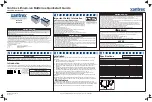
SENS IQ Technical Manual
20
Service Hotline: 1.800.742.2326
1.303.678.7500
Main Menus
(Press up and down
arrows to scroll
through Main Menu
Options)
Configurable/Viewable
Parameters
(Press left and right arrows
to scroll through choices
within each Menu Option)
Parameter Descriptions/Definitions
ALARM
SETTINGS
(cont.)
Overvolt shutdown
Adjust VpC setpoint to trigger Over Voltage Shutdown alarm. Adjustable from
2.20 - 2.60 VpC for flooded lead acid and VRLA batteries, 1.50 - 1.75 VpC for
NiCd.* May not be lower than High DC volt alarm setting.
Low current alarm
Adjust from 2% to 50% of nominal current setpoint to trigger Low Current alarm
(See Section 9.3 for
alarm definitions)
Ground fault alarm
sensitivity
Enable or disable Ground Fault alarm. Select OFF to disable or select level of sensi-
tivity for ground fault - HIGH, MED, or LOW. LOW sensitivity indicates alarm is
hardest to trip, HIGH indicates alarm is most sensitive. Sensitivity is represented by
resistance values, /- 30% tolerance, as shown in the following table:
Seconds delay alarm relays
Adjust amount of time from 5 to 50 seconds to delay activation of alarm relay con-
tacts after alarm event takes place.
BATTERY CHECK Periodic auto battery check
Set to ON or OFF. Charger will automatically engage a Battery Check test on a
periodic interval configured by user.
Battery Check front panel
button
Set to ON to allow user to engage Battery Check test from front panel BATT CHCK
button. Set to OFF to disable use of button.
Days battery check interval Adjust amount of time from 1 to 60 days between periodic Battery Check tests
Minutes batt. check duration Adjust amount of time from 1 to 60 minutes to run Battery Check test
V min. allowed DC bus
Adjust VpC for minimum voltage allowed during Battery Check test. Adjustable
from 1.80 - 2.06 VpC for flooded lead acid and VRLA batteries, 1.125 - 1.287 VpC
for NiCd. Must be lower than Float V setting by at least 2% of nominal battery
voltage.
TEMPERATURE
INFO
ambient temperature
Displays ambient temperature and warnings about over and under charging the bat-
tery.
UNIT SETUP
Battery temp. compensation
Set to ON or OFF. Temperature compensation of the charger output voltage may be
implemented either locally or remotely. Chargers include local temperature com-
pensation by default. Remote temperature compensation is offered via an optional
external device located at the batteries. Temperature compensation is active between
0°C/32°F and 40°C/104°F (see
FIG 7
). Temperature compensation will automati-
cally scale back output voltage to prevent conflicts with high and low voltage alarm
settings and Over Voltage Shutdown setting.
Temp comp slope
Adjust temperature compensation slope from 1.0 to -5.5mV/cell/°C for lead-acid
batteries and 0.75 to -4.0mV/cell/°C for nickel-cadmium batteries. See
FIG 7
for
examples of slope selections.
Audio alarm indication
(available with version 3.00
or later firmware)
Set to ON or MUTE. Activates or silences audible alarm indication.
Change battery/type
(available with version 3.00
or later firmware)
Select type of battery to be charged - Flooded Lead-Acid, VRLA or Nickel-
Cadmium (see Section 8.5)
Table continued on next page
*Settings for alarm voltages and over voltage shutdown contain an anti-collision feature that prevents
false alarms and shutdown due to operator error. Adjustments are limited to maintain a 2% "guard
band" between alarm trip points and the output set points.
LOW
MED
12 VDC
3K
Ω
0.21mA 10K
Ω
0.13mA 30K
Ω
0.06mA
24 VDC
3K
Ω
0.41mA 10K
Ω
0.25mA 30K
Ω
0.11mA
48 VDC
10K
Ω
0.25mA 30K
Ω
0.15mA 100K
Ω
0.07mA
120VDC
10K
Ω
0.62mA 30K
Ω
0.38mA 100K
Ω
0.17mA
240VDC
20K
Ω
0.63mA 60K
Ω
0.38mA 200K
Ω
0.17mA
HIGH
















































